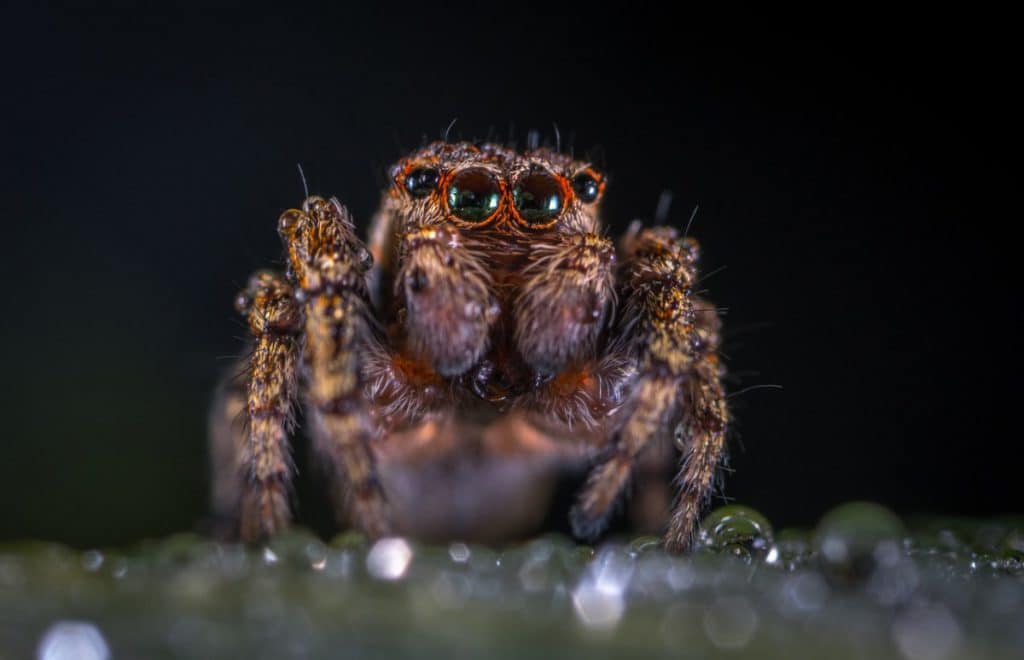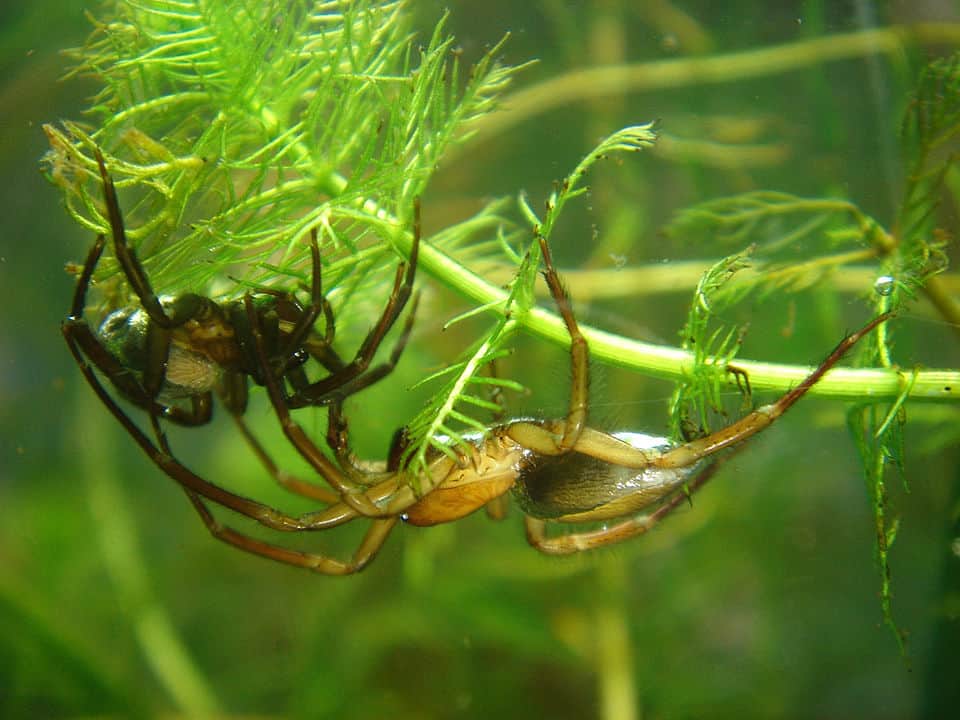
Anytime we have seen a spider in the sink and tried to wash-it away with water we may have wondered, Can spiders swim? Some such as diving bell spiders can, but most either crawl on items underwater or try to run across the surface of water.
Put simply, if you hit a little spider with a bunch of fast-moving water from your sink-faucet you do not need to worry about it swimming-up against the current like some kind of eight-legged Michael Phelps, but is worth learning about the kinds of spiders that can swim, or otherwise survive in the water in fascinating ways!
The Species of Spiders That Swim
| Spider | Can they swim? |
| Tarantulas | Yes (not well) |
| Dolomedes | Yes |
| Northern Tree Funnel-Web spider | Yes |
| Dolomedes briangreenei (newly discovered) | Yes |
| House Spiders | No |
| Brown Recluse | No |
Can Tarantulas Swim?
First off, everyone knows those fuzzy and kinda-cute-but-also-scary spiders known as Tarantulas. Now, Tarantulas have at times been observed clumsily swimming along the tops or lakes or other pools of water, using they legs much like oars on a boat as they carefully spread their weight-out and row along, but despite popular web-videos of them doing so like this one that made the rounds over the Summer:
they are actually not very, “At home,” in the water compared to other spiders that are about to be discussed which find the water a great deal more tolerable.
Tarantulas are fascinating. Want more tarantula facts? Check out Everything You Need to Know About Rose Hair Tarantulas!
Diving spiders
Spiders that do quite well in the water within North America are the species commonly referred to as, “Diving spiders,” with their official names being the Dolomedes species. Some people call them, “Raft spiders,” “Dock spiders,” or, “Wharf spiders,” as they are often found hanging around rafts, docks, or wharfs (as the name implies).
They are semi-aquatic and can spread their legs out to swim so that they cover up to four inches per stroke along the water. They are not poisonous to humans and not something to be afraid of even if seeing them skitter-about atop the surface of water can be a little scary!
A recently discovered species of spider is the Australian, “Dolomedes Briangreene,” which is a part of the, “Diving spiders,” species but a little more intimidating than its American brethren. Called the “Brisbane spider,” for short, it is about the size of a grown-adult’s palm and floats along the top of water, using the vibrations of creatures swimming to located prey. They have been observed eating tadpoles, frogs, and even decently-sized fish they dive-down and grab before swimming back up!
Can Northern Tree Funnel-Web spiders swim?
Another Australian spider capable of swimming is the Northern Tree Funnel-Web spider, which has venom that is painfully poisonous to humans. However, this kind of spider thankfully is much like the above-discussed Tarantula in that while it can swim it honestly does not really prefer to, instead often found nesting in trees–as its namesake indicates.
They most commonly seem to accidentally end-up in watery situations at time when they wash-up into people’s swimming pools and then find themselves trying to escape (and hopefully not biting anyone with their poisonous bite in the process).
Can Diving Bell spiders swim?
The spider that is the most impressive swimmer by far is the Diving Bell spider. This kind of spider spends almost all of its life underwater and is found in still freshwater within Europe as well as Asia. It will often spend almost a whole day underwater, only briefly coming above it to gather more air before submersing itself again. This air is stored in little pockets upon the spider’s body via its hair as well as little, “Bells,” weaved from its web.

These spiders eat small aquatic insects, mosquito larvae, and sometimes very small crustaceans as their prey whilst living the majority of their life underwater. Should a Diving Bell spider ever bite you it is reassuring to know that it is not poisonous to humans, but do know that its bite is apparently extremely painful with the reason being unclear but one theory being they have significantly large fangs for their size.
Besides these species of spiders you may casually observe even kinds that are not normally adept at navigating water can at times handle being hit with some droplets (such as from rain) or can quickly run across a small body of water as opposed to sinking. Hence, while a common house-spider like a Brown Recluse would much rather live in a dry and quiet garage, if an emergency arose it would handle navigating around a body of water or getting a bit wet.
How Can Spiders Swim?
Spiders swim a lot like we do, they kick their legs, all eight of them! However, when it comes to how spiders can swim it can depend on what species of spider we are talking about. Those less adept at swimming such the Tarantula or Northern Tree Funnel-Web spider are more awkward and clumsy in their swimming. They distribute their weight and slowly cruise along the surface of the water, making a great effort to not actually go underwater generally.
If you enjoy reading this article, why not check out our articles on Can Spiders See in the Dark? The Complete Answer and What do Praying Mantis’ Eat? A Complete Guide
This is quite different from spiders more adept at swimming such as Diving Spiders which can scoot around atop water with little difficulty and even at times will dive under–with the Brisbane spider being so skilled at swimming and diving it can grab fish with some of its limbs and the swim back to the surface with its other arms!
Then we have the Diving Bell spider which actually is much more adept at living in the water than it is surviving on land–it swims like nobody’s business and barely ever even surfaces except when it has to replenish its air. All of these spiders can swim, but some clearly are more skilled at utilizing their legs to do it than others.
The key is the spiders know to distribute their body-weight when they want to float and how to thrust downward when (or if) they want to dive. Just as with humans some of us are better swimmers than others, some kinds of spiders managed the art of swimming a lot better than other kinds in the World.
Can you Drown a Spider?
It has been established that the kinds of spiders who are comfortable with swimming can often be in the water for a long period of time, but what about those species not at all well adapted to an aquatic environment? Well, they can be drowned but it can take a good deal of time. Due to the fact that spiders in general have a lower metabolic rate even the kind not at all used to the water can sometimes survive for up to an hour without oxygen.
Basically, if you need to kill a spider trying to drown it is simply not the way to go about doing it. Your best options are to try and smash a spider, or if you have the kind of tools or weather to do so, freeze it. That’s right, as this article (https://www.smithsonianmag.com/smart-news/if-you-must-kill-that-spider-the-best-way-is-to-freeze-it-88586004/) describes, as hard as it might be to crush a fast-moving spider or drown them, they are very susceptible to the cold. Think of it as their one big weakness.
Curious about how else spiders can die? Find out by reading What Can Spiders Die From? The Curious Answer!
Do Spiders Breathe Underwater?
If one is asking if they ever breathe underwater in the sense of actually having gills, the answer is, “No, never.” However, as we have talked about there are spiders such as the Diving Bell spider which is extremely talented at trapping pockets of air it then takes deep underwater with it when it submerges which it then is able to periodically bring to its mouth to, “Breathe,” while underwater.
It is therefore technically breathing underwater, but not in the regular sense of how a fish does. It simply is talented enough to bring air from above water down with it and then carefully ration it out throughout the day. As intimidating as it might be to think about a spider living underwater for long periods of time, the fact is that they do not actually have the ability to stay underwater totally; spiders cannot actually breathe underwater, some just have a lot of tricks to help them stay there for long periods of time.
Conclusion
When it comes to the query, “Can spiders swim,” the answer is a little more complicated than we might have suspected at first! While a number of species of spiders are not really capable of swimming, even those who struggle with water can generally survive being submerged for up to an hour despite lacking much skill in aquatic environments.
Then, there are those spiders who actually have managed to swim to some degree but honestly struggle a great deal to do so (like Tarantulas and the Northern Tree Funnel-Web spider). We also have spiders that a quite adept at swimming, such as the diving spiders which find a semi-aquatic life quite enjoyable, some of them being so good at swimming they excel at catching prey such a decently-sized fish!
The Diving Bell spider clearly takes the cake when we are discussing spiders who can swim however, spending almost a day at a time underwater using its skills at making, “Bells,” of air to not truly, “Breathe underwater,” but come impressively close with its life spent almost 99% of the time submerged!
Not all spiders can swim, but those that can often do so quite well. Again, however, if you are blasting a spider with a bunch of water in your shower or flush it down the toilet into the sewage system no arachnid is powerful enough to swim back-up, so rest assured you will at least be safe in that regard!
References
I used several research papers to help me put this article together. If you want to read them, here are the links:
If you enjoyed reading this article, why not check out our articles on Can Insects See in Color? Let’s Find Out! and Can Butterflies See Color? Let’s Find Out!
Recent Posts
Tiny Black Bugs in Bathroom NO WINGS: What They Are and What to Do!
Finding tiny black bugs in your bathroom can be uncomfortable, to say the least. Especially if they are persistent, or they appear in very large numbers, which they often like to do. When it...
Tiny Black Bugs in Plant Soil - What Are They & What To Do About It
A short horror story: You get a new houseplant. You do your best to take care of it. You’ve ensured that it has the right soil, the right amount of sun, it gets enough water. And then one day, you...

